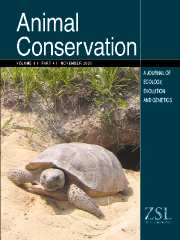Crossref Citations
This article has been cited by the following publications. This list is generated based on data provided by
Crossref.
Young, Julie K.
and
Shivik, John A.
2006.
What carnivore biologists can learn from bugs, birds, and beavers: a review of spatial theories.
Canadian Journal of Zoology,
Vol. 84,
Issue. 12,
p.
1703.
Azevedo, Cristiano S. de
and
Young, Robert J.
2006.
Shyness and boldness in greater rheas Rhea americana Linnaeus (Rheiformes, Rheidae): the effects of antipredator training on the personality of the birds.
Revista Brasileira de Zoologia,
Vol. 23,
Issue. 1,
p.
202.
Molony, Susie E.
Dowding, Claire V.
Baker, Philip J.
Cuthill, Innes C.
and
Harris, Stephen
2006.
The effect of translocation and temporary captivity on wildlife rehabilitation success: An experimental study using European hedgehogs (Erinaceus europaeus).
Biological Conservation,
Vol. 130,
Issue. 4,
p.
530.
Teixeira, Camila P.
de Azevedo, Cristiano Schetini
Mendl, Mike
Cipreste, Cynthia F.
and
Young, Robert J.
2007.
Revisiting translocation and reintroduction programmes: the importance of considering stress.
Animal Behaviour,
Vol. 73,
Issue. 1,
p.
1.
Boon, Adrienne K.
Réale, Denis
and
Boutin, Stan
2008.
Personality, habitat use, and their consequences for survival in North American red squirrels Tamiasciurus hudsonicus.
Oikos,
Vol. 117,
Issue. 9,
p.
1321.
Briffa, Mark
Rundle, Simon D
and
Fryer, Adam
2008.
Comparing the strength of behavioural plasticity and consistency across situations: animal personalities in the hermit crab
Pagurus bernhardus
.
Proceedings of the Royal Society B: Biological Sciences,
Vol. 275,
Issue. 1640,
p.
1305.
Powell, David M.
and
Svoke, Joseph T.
2008.
Novel Environmental Enrichment May Provide a Tool for Rapid Assessment of Animal Personality: A Case Study With Giant Pandas (Ailuropoda melanoleuca).
Journal of Applied Animal Welfare Science,
Vol. 11,
Issue. 4,
p.
301.
Jule, Kristen R.
Leaver, Lisa A.
and
Lea, Stephen E.G.
2008.
The effects of captive experience on reintroduction survival in carnivores: A review and analysis.
Biological Conservation,
Vol. 141,
Issue. 2,
p.
355.
Smith, Brian R.
and
Blumstein, Daniel T.
2008.
Fitness consequences of personality: a meta-analysis.
Behavioral Ecology,
Vol. 19,
Issue. 2,
p.
448.
Vasconcellos, AS
Guimarães, MABV
Oliveira, CA
Pizzutto, CS
and
Ades, C
2009.
Environmental enrichment for maned wolves(Chrysocyon brachyurus):group and individual effects.
Animal Welfare,
Vol. 18,
Issue. 3,
p.
289.
Maran, Tiit
Põdra, Madis
Põlma, Merje
and
Macdonald, David W.
2009.
The survival of captive-born animals in restoration programmes – Case study of the endangered European mink Mustela lutreola.
Biological Conservation,
Vol. 142,
Issue. 8,
p.
1685.
Briffa, Mark
and
Bibost, Anne-Laurence
2009.
Effects of shell size on behavioural consistency and flexibility in hermit crabs.
Canadian Journal of Zoology,
Vol. 87,
Issue. 7,
p.
597.
Fucikova, Eva
Drent, Piet J.
Smits, Nadine
and
Van Oers, Kees
2009.
Handling Stress as a Measurement of Personality in Great Tit Nestlings (Parus major).
Ethology,
Vol. 115,
Issue. 4,
p.
366.
O’Donnell, Stephanie
Webb, Jonathan K.
and
Shine, Richard
2010.
Conditioned taste aversion enhances the survival of an endangered predator imperilled by a toxic invader.
Journal of Applied Ecology,
Vol. 47,
Issue. 3,
p.
558.
Carter, Alecia J.
Goldizen, Anne W.
and
Tromp, Sara A.
2010.
Agamas exhibit behavioral syndromes: bolder males bask and feed more but may suffer higher predation.
Behavioral Ecology,
Vol. 21,
Issue. 3,
p.
655.
WILSON, RYAN R.
HOOTEN, MEVIN B.
STROBEL, BRADLEY N.
and
SHIVIK, JOHN A.
2010.
Accounting for Individuals, Uncertainty, and Multiscale Clustering in Core Area Estimation.
The Journal of Wildlife Management,
Vol. 74,
Issue. 6,
p.
1343.
Jones, Megan Anne
van Lierop, Mathew
Mason, Georgia
and
Pillay, Neville
2010.
Increased reproductive output in stereotypic captive Rhabdomys females: Potential implications for captive breeding.
Applied Animal Behaviour Science,
Vol. 123,
Issue. 1-2,
p.
63.
Swaisgood, RR
2010.
The conservation-welfare nexus in reintroduction programmes: a role for sensory ecology.
Animal Welfare,
Vol. 19,
Issue. 2,
p.
125.
Smith, Brian R.
and
Blumstein, Daniel T.
2010.
Behavioral types as predictors of survival in Trinidadian guppies (Poecilia reticulata).
Behavioral Ecology,
Vol. 21,
Issue. 5,
p.
919.
WATERS, S. S.
2010.
Swift fox Vulpes velox reintroductions: a review of release protocols.
International Zoo Yearbook,
Vol. 44,
Issue. 1,
p.
173.


